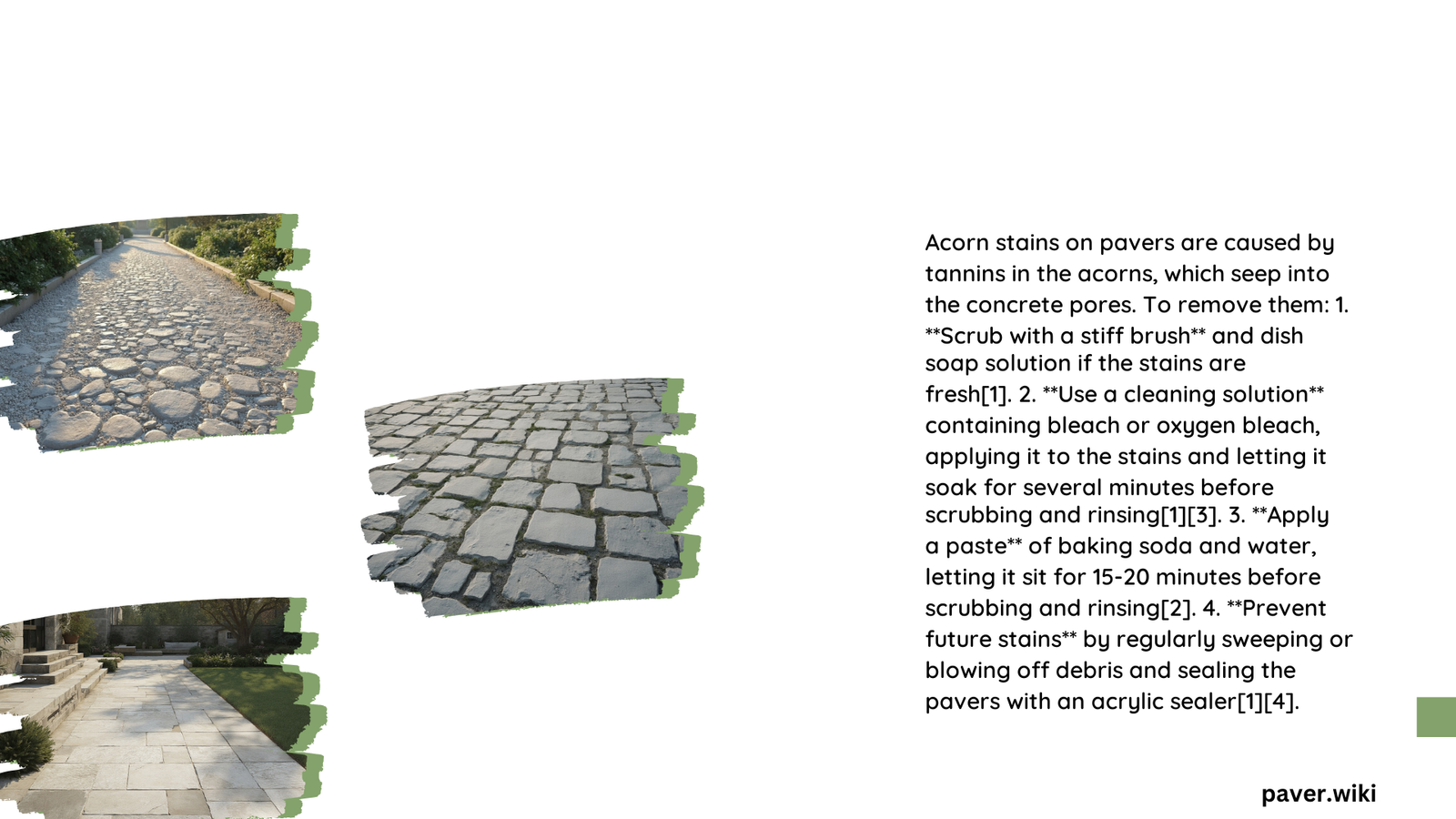Acorn stains on pavers are a common issue for homeowners with oak trees nearby. These stains, caused by tannins in acorns, can be stubborn and unsightly. Effective removal methods include using sodium hypochlorite solutions or specialized concrete cleaners. Prevention techniques involve regular cleaning and applying sealants. This comprehensive guide explores various aspects of dealing with acorn stains on pavers, from understanding their nature to implementing long-term preventive measures.
What Causes Acorn Stains on Pavers?
Acorn stains on pavers are primarily caused by tannins, which are natural compounds found in acorns and other plant materials. When acorns fall on pavers and decompose, they release these tannins, which can penetrate the porous surface of the pavers, leaving behind dark, stubborn stains.
Factors that contribute to acorn staining include:
- Prolonged contact between acorns and pavers
- Moisture, which accelerates the decomposition process
- Porous nature of certain paver materials
- Lack of protective sealants on the pavers
How Do Chemical Compositions and pH Levels Affect Acorn Stain Removal?

The effectiveness of acorn stain removal largely depends on the chemical composition and pH levels of the cleaning agents used. Here’s a breakdown of two common cleaning solutions:
- Sodium Hypochlorite Solution
- Composition: 50/50 mixture of sodium hypochlorite (bleach) and water
- pH Level: High, but diluted for safer use
-
Effectiveness: Highly effective due to its oxidizing properties
-
Light Duty Concrete Cleaner
- Composition: Non-etching acidic cleaner
- pH Level: Mildly acidic
- Effectiveness: Effective for various stains, including tannins
| Cleaner Type | pH Level | Effectiveness on Acorn Stains |
|---|---|---|
| Sodium Hypochlorite Solution | High (diluted) | Very High |
| Light Duty Concrete Cleaner | Mildly Acidic | High |
What Are the Step-by-Step Techniques for Removing Acorn Stains?
Method 1: Using Sodium Hypochlorite Solution
- Prepare a 50/50 solution of sodium hypochlorite and water
- Apply the solution using a pump-up sprayer
- Allow it to dwell for 15 minutes
- Rinse thoroughly with water
- Repeat if necessary
Method 2: Using Light Duty Concrete Cleaner
- Apply the cleaner as per product instructions
- Allow it to dwell for the recommended time
- Rinse thoroughly with water
- Repeat if needed
Both methods require protective gear such as gloves and safety goggles.
How Can Acorn Stains on Pavers Be Prevented?
Preventing acorn stains is often easier and more cost-effective than removal. Here are some preventive measures:
- Apply Sealants
- Use high-quality paver sealants
- Reapply every 1-3 years
-
Estimated cost: $0.50 to $2.00 per square foot
-
Regular Cleaning
- Sweep or blow away acorns and leaves regularly
-
Clean pavers with mild detergent and water periodically
-
Prompt Removal
- Remove fallen acorns as soon as possible
- Clean any visible stains immediately
What Is the Effectiveness of Various Acorn Stain Treatment Methods?
The effectiveness of acorn stain treatments can vary. Here’s a comparison:
| Treatment Method | Stain Removal % | Time Required | Long-term Protection |
|---|---|---|---|
| Sodium Hypochlorite Solution | 90-100% | 30-60 minutes | No |
| Light Duty Concrete Cleaner | Significant (exact % varies) | 30 minutes to several hours | No |
Both methods are effective for stain removal but do not provide long-term protection against future stains.
How Does the Type of Paver Material Affect Acorn Staining?
The susceptibility of pavers to acorn staining varies depending on the material:
- Concrete Pavers
- More porous
- Higher susceptibility to staining
-
Easier to seal
-
Natural Stone Pavers
- Varies by stone type
- Some are more resistant (e.g., granite)
-
Others are more susceptible (e.g., limestone)
-
Clay Pavers
- Generally less porous
- More resistant to staining
- May be more challenging to seal effectively
What Are the Environmental Considerations When Treating Acorn Stains?
When dealing with acorn stains on pavers, it’s important to consider the environmental impact:
- Chemical Runoff: Ensure proper disposal of cleaning solutions to prevent harm to plants and wildlife.
- Water Usage: Be mindful of water consumption during the cleaning process.
- Eco-Friendly Alternatives: Consider using biodegradable or environmentally friendly cleaning products when possible.
How Does Weather Affect Acorn Staining and Treatment?
Weather conditions play a significant role in both the formation and treatment of acorn stains:
- Rainy Weather: Increases the likelihood of staining due to accelerated acorn decomposition.
- Hot, Dry Weather: May set stains more quickly, making them harder to remove.
- Freezing Temperatures: Can cause acorns to crack, releasing tannins more rapidly.
For optimal results, treat stains in mild, dry weather conditions.
What Are the Long-Term Maintenance Strategies for Acorn-Prone Paver Areas?
To maintain paver areas prone to acorn staining:
- Implement a regular cleaning schedule
- Apply and maintain protective sealants
- Consider installing physical barriers like netting during peak acorn fall seasons
- Prune overhanging oak branches to reduce acorn fall
- Educate household members on prompt acorn removal
By following these strategies, homeowners can significantly reduce the occurrence and severity of acorn stains on their pavers, maintaining the aesthetic appeal of their outdoor spaces.
References:
1. Light Duty Concrete Cleaner – PROSOCO Sure Klean
2. How To Clean Leaf & Acorn Stains On Concrete Driveway – YouTube
3. Paver Cleaners and Strippers – CoverTec Products
